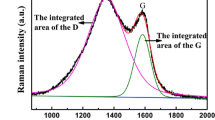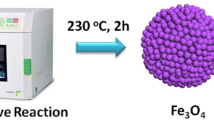Abstract
In this work, we report a general and feasible approach for the fabrication of Fe3O4/carbon nanotubes (CNTs) nanocomposite through a hydrothermal method followed by an in situ thermal reduction, without any reducing agents. The nanocomposite was characterized by x-ray power diffraction (XRD) and scanning electron microscopy (SEM). The results revealed that the CNTs in the prepared Fe3O4/CNTs nanocomposite intertwines with Fe3O4 nanoparticles to form a three-dimensional (3D) network wiring, and almost all the Fe3O4 nanoparticles with diameters ranging from 50 to 100 nm. The electrochemical performance of the Fe3O4/CNTs nanocomposite displayed an initial discharge capacity of 1,421 mAh g−1 and maintained 1,030 mAh g−1 up to 55 cycles at 0.1 C (1 C = 924 mAh g−1). When the current density is 0.5, 1, 2, 5, and 1 C, the Fe3O4/CNTs nanocomposite still exhibited discharge capacity of 1,049, 995, 802, 433, and (950 ± 50) mAh g−1, respectively. Compared to commercial Fe3O4, the Fe3O4/CNTs nanocomposite showed enhanced cycling performance and high-rate capability due to the synergetic effects, highlighting the importance of maximum use of the Fe3O4 and CNTs for energy storage applications in high-performance lithium-ion batteries (LIBs).










Similar content being viewed by others
References
Lin YM, Nagarale RK, Klavetter KC, Heller A, Mullins AC (2012) SnO2 and TiO2-supported-SnO2 lithium anodes with improved electrochemical performance. J Mater Chem 22:11134–11139
Magasinski A, Dixon P, Hertzberg B, Kvit A, Ayala J, Yushin G (2010) High-performance lithium-ion anodes using a hierarchical bottom-up approach. Nat Mater 9:353–358
Li T, Ai XP, Yang HX (2011) Reversible electrochemical conversion reaction of Li2O/CuO nanocomposites and their application as high-capacity cathode materials for li-ion batteries. J Phys Chem C 115:6167–6174
Xiang JY, Tu JP, Qiao YQ, Wang XL, Zhong J, Zhang D, Gu CD (2011) Electrochemical impedance analysis of a hierarchical CuO electrode composed of self-assembled nanoplates. J Phys Chem C 115:2505–2513
Wang LL, Cheng W, Gong HX, Wang CH, Wang D, Tang KB, Qian YT (2012) Facile synthesis of nanocrystalline-assembled bundle-like CuO nanostructure with high rate capacities and enhanced cycling stability as an anode material for lithium-ion batteries. J Mater Chem 22:11297–11302
Ding SJ, Chen JS, Qi GG, Duan XN, Wang ZY, Giannelis EP, Archer LA, Lou XW (2011) Formation of SnO2 hollow nanospheres inside mesoporous silica nanoreactors. J Am Chem Soc 233:21–23
Wang Y, Zeng HC, Lee JY (2006) Highly reversible lithium storage in porous SnO2 nanotubes with coaxially grown carbon nanotube overlayers. Adv Mater 18:645–649
Xia H, Wan YH, Yuan GL, Fu FS, Wang X (2014) Fe3O4/carbon coreeshell nanotubes as promising anode materials for lithium-ion batteries. J Power Sources 241:486–493
Ban C, Wu ZC, Gillaspie DT, Chen L, Yan YF, Blackburn JL, Dillon AC (2010) Nanostructured Fe3O4/SWNT electrode: binder-free and high-rate li-ion anode. Adv Mater 22:E145–E149
Tian LL, Zhuang QC, Li J, Wu C, Shi YL, Sun SG (2012) The production of self-assembled Fe2O3-graphene hybrid materials by a hydrothermal process for improved li-ion insertion. Electrochim Acta 65:153–158
Du N, Zhang H, Chen BD, Wu JB, Ma XY, Liu ZH, Zhang YQ, Yang DR, Huang XH, Tu JP (2007) Porous Co3O4 nanotubes derived from Co4(CO)12 clusters on carbon nanotube templates: a highly efficient material for li-battery applications. Adv Mater 19(24):4505–4509
Wu ZS, Ren WC, Wen L, Gao LB, Zhao JP, Chen ZP, Zhou GM, Li F, Cheng HM (2010) Graphene anchored with Co3O4 nanoparticles as anode of lithium ion batteries with enhanced reversible capacity and cyclic performance. ACS Nano 4(6):3187–3194
Ma SB, Nam KW, Yoon WS, Bak SM, Yang XQ, Cho BW, Kim KB (2009) Nano-sized lithium manganese oxide dispersed on carbon nanotubes for energy storage applications. Electrochem Commun 11(8):1575–1578
Liu R, Duay J, Lee SB (2010) Redox exchange induced MnO2 nanoparticle enrichment in poly (3,4-ethylenedioxythiophene) nanowires for electrochemical energy storage. ACS Nano 4(7):4299–4307
Behera SK (2011) Facile synthesis and electrochemical properties of Fe3O4 nanoparticles for li ion battery anode. J Power Sources 196:8669–8674
Wang SQ, Zhang JY, Chen CH (2010) Fe3O4 submicron spheroids as anode materials for lithium-ion batteries with stable and high electrochemical performance. J Power Sources 195:5379–5381
Zhang M, Yin XM, Du ZF, Liu S, Chen LB, Li QH, Jin H, Peng K, Wang TH (2010) Fe3O4 dendrites reduced by carbon-coatings as high reversible capacity anodes for lithium ion batteries. Solid State Sci 12:2024–2029
Wang JZ, Zhong C, Wexler D, Idris NH, Wang ZX, Chen LQ, Liu HK (2011) Graphene-encapsulated Fe3O4 nanoparticles with 3D laminated structure as superior anode in lithium ion batteries. Chem Eur J 17:661–667
Piao YZ, Kim HS, Sung YE, Hyeon T (2010) Facile scalable synthesis of magnetite nanocrystals embedded in carbon matrix as superior anode materials for lithium-ion batteries. Electrochem Commun 46:118–120
Wu P, Du N, Zhang H, Yu JX, Yang DR (2011) Carbon nanocapsules as nanoreactors for controllable synthesis of encapsulated iron and iron oxides: magnetic properties and reversible lithium storage. J Phys Chem C 115:3612–3620
Jin SL, Deng HG, Long DH, Liu XJ, Zhan L, Liang XY, Qiao WM, Ling LC (2011) Facile synthesis of hierarchically structured Fe3O4/carbon micro-flowers and their application to lithium-ion battery anodes. J Power Sources 115:3887–3893
Zhang J, Hu YS, Tessonnier JP, Weinberg G, Maier J, Schlogl R, Su DS (2008) CNF@CNTs: superior carbon for electrochemical energy storage. Adv Mater 20:1450–1455
Masarapu C, Subramanian V, Zhu HW, Wei BQ (2009) Long-cycle electrochemical behavior of multiwall carbon nanotubes synthesized on stainless steel in li ion batteries. Adv Funct Mater 19:1008–1014
Li YL, Wang JJ, Li XF, Liu J, Geng DS, Yang JL, Li RY, Sun XL (2011) Nitrogen-doped carbon nanotubes as cathode for lithium-air batteries. Electrochem Commun 13:668–672
Martin C, Crosnier O, Retoux R, Belanger D, Schleich DM, Brousse T (2011) Chemical coupling of carbon nanotubes and silicon nanoparticles for improved negative electrode performance in lithium-ion batteries. Adv Funct Mater 21:3524–3530
Kawasaki N, Wang H, Nakanishi R, Hamanaka S, Kitaura R, Shinohara H, Yokoyama T, Yoshikawa H, Awaga K (2011) Nanohybridization of polyoxometalate clusters and single-wall carbon nanotubes: applications in molecular cluster batteries. Angew Chem Int Ed 50:3471–3474
Xiang XX, Huang ZZ, Liu EH, Shen HJ, Tian YY, Xie H, Wu YH, Wu ZL (2011) Lithium storage performance of carbon nanotubes prepared from polyaniline for lithium-ion batteries. Electrochim Acta 56:9350–9356
Nakaoka SIK, Kawamura A, Fujimoto KUK, Koura N (2005) Lithium battery having a large capacity using Fe3O4 as a cathode material. J Power Sources 146:319–322
Hsieh CT, Lin JY, Mo CY (2011) Improved storage capacity and rate capability of Fe3O4-graphene anodes for lithium-ion batteries. Electrochim Acta 58:119–124
Mitra S, Poizot P, Finke A, Tarascon JM (2006) Growth and electrochemical characterization versus lithium of Fe3O4 electrodes made by electrodeposition. Adv Funct Mater 16:2281–2287
Lian PC, Zhu XF, Xiang HF, Li Z, Yang WS, Wang HH (2010) Enhanced cycling performance of Fe3O4-graphene nanocomposites as an anode material for lithium-ion batteries. Electrochim Acta 56:834–840
He Y, Huang L, Cai JS, Zheng XM, Sun SG (2010) Structure and electrochemical performance of nanostructured Fe3O4/carbon nanotube composites as anodes for lithium ion batteries. Electrochim Acta 55:1140–1144
NuLi Y, Zeng R, Zhang P, Guo ZP, Liu HK (2008) Controlled synthesis of α-Fe2O3 nanostructures and their size-dependent electrochemical properties for lithium-ion batteries. J Power Sources 148:456–461
Ortiz GF, Hanzu I, Lavela P, Tirado JL, Knauth P, Djenizian T (2010) A novel architectured negative electrode based on titania nanotubes and iron oxide nanowire composites for li-ion microbatteries. J Mater Chem 20:4041–4046
Huang YD, Dong ZF, Jia DZ, Guo ZP, Cho W (2011) Preparation and characterization of core-shell structure Fe3O4/C nanoparticles with unique stability and high electrochemical performance for lithium-ion battery anode material. Electrochim Acta 56:9233–9239
Yoon T, Chae C, Sun YK, Zhao X, Kung HH, Lee JK (2011) Bottom-up in situ formation of Fe3O4 nanocrystals in a porous carbon foam for lithium-ion battery anodes. J Mater Chem 21:17325–17330
Zhang WD, Wang XY, Zhou HH, Chen JT, Zhang XX (2012) Fe3O4-C open hollow sphere assembled by nanocrystals and its application in lithium ion battery. J Alloys Compd 521:39–44
Wu XL, Guo YG, Wan LJ, Hu CW (2008) α-Fe2O3 nanostructures: inorganic salt-controlled synthesis and their electrochemical performance toward lithium storage. J Phys Chem C 112:16824–16829
Uzunova S, Uzunov I, Kovacheva D, Momchilov A, Puresheva B (2006) A low external temperature method for synthesis of active electrode materials for li batteries – Part B: synthesis of lithium iron oxides Li x Fe y O z . J Appl Electrochem 36:1333–1339
Poizot P, Laruelle S, Grugeon S, Dupont L, Tarascon JM (2001) Searching for new anode materials for the li-ion technology: time to deviate from the usual path. J Power Sources 97:235–239
Zhu XJ, Wu WY, Liu Z, Li L, Hu J, Dai HL, Ding L, Zhou K, Wang CY, Song XG (2013) A reduced graphene oxide-nanoporous magnetic oxide iron hybrid as an improved anode material for lithium ion batteries. Electrochim Acta 95:24–28
Wen ZH, Wang Q, Zhuang Q, Li JH (2007) In situ growth of mesoporous SnO2 on multiwalled carbon nanotubes: a novel composite with porous-tube structure as anode for lithium batteries. Adv Funct Mater 17:2772–2778
Wu C, Zhuang QC, Wu YX, Tian LL, Cui YL, Zhang XX (2013) Facile synthesis of Fe3O4 hollow spheres/carbon nanotubes composites for lithium ion batteries with high-rate capacity and improved long-cycle performance. Mater Lett 113:1–4
Qiu XY, Zhuang QC, Zhang QQ, Cao R, Ying PZ, Qiang YH, Sun SG (2012) Electrochemical and electronic properties of LiCoO2 cathode investigated by galvanostatic cycling and EIS. Phys Chem Chem Phys 14:2617–2630
Zhuang QC, Wei T, Du LL, Cui YL, Fang L, Sun SG (2010) An electrochemical impedance spectroscopic study of the electronic and ionic transport properties of spinel LiMn2O4. J Phys Chem C 114(18):8614–8621
Shin HC, Cho WI, Jang H (2006) Electrochemical properties of the carbon-coated LiFeO4 as a cathode material for lithium-ion secondary batteries. J Power Sources 159:1383–1388
Aurbach D, Nimberger A, Markovsky B, Levi E, Sominski E, Gedanken A (2002) Nanoparticles of SnO produced by sonochemistry as anode materials for rechargeable lithium batteries. Chem Mater 14:4155–4163
Kang YM, Song MS, Kim JH, Kim HS, Park MS, Lee JY, Liu HK, Dou XS (2005) A study on the charge–discharge mechanism of Co3O4 as an anode for the li ion secondary battery. Electrochim Acta 50:3667–3773
Needham SA, Wang GX, Konstantinov K, Tournayre Y, Lao Z, Liu HK (2006) Electrochemical performance of Co3O4-C composite anode materials. Electrochem Solid State Lett 9:A315–A319
Bao WJ, Zhuang QC, Xu SD, Cui YL, Shi YL, Qiang YH (2013) Investigation of electronic and ionic transport properties in α-MoO3 cathode material by electrochemical impedance spectroscopy. Ionics 19:1005–1013
Reddy MV, Madhavi S, Rao AGV, Chowdari BVR (2006) Metal oxyfluorides TiOF2 and NbO2F as anodes for li-ion batteries. J Power Sources 62:1312–1321
Reddy MV, Yu T, Sow CH, Shen ZX, Lim CT, Subba Rao GV, Chowdari BVR (2007) α-MoO3 nanoflakes as an anode material for li-ion batteries. Adv Funct Mater 17:2792–2799
Acknowledgments
The authors acknowledge financial supports by the High School Research Project of Anhui Provincial Natural Science Foundation (KJ2013B208).
Author information
Authors and Affiliations
Corresponding author
Rights and permissions
About this article
Cite this article
Wu, Y., Liu, J., Wu, C. et al. Magnetite/carbon nanotubes nanocomposite: facile hydrothermal synthesis and enhanced cycling performance and high-rate capability as anode material for lithium-ion batteries. Ionics 21, 635–643 (2015). https://doi.org/10.1007/s11581-014-1204-2
Received:
Revised:
Accepted:
Published:
Issue Date:
DOI: https://doi.org/10.1007/s11581-014-1204-2




